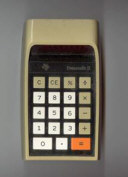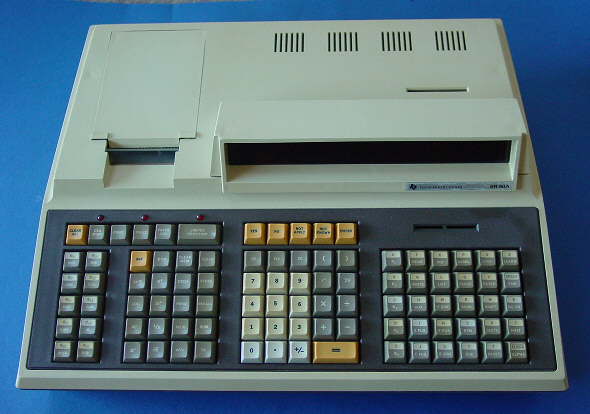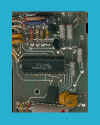
DATAMATH CALCULATOR MUSEUM
 |
DATAMATH CALCULATOR MUSEUM |
Texas Instruments SR-60A
| Date of introduction: | 1977 January 13, 1978 (Germany) |
Display technology: | LED |
| New price: | $1995.00 (March 28, 1978) DM 6995.00 (SRP 1978) |
Display size: | 20 dot-matrix |
| Size: | 14.5" x 17" x 5.5" | Printer technology: | Thermal TP-30250 | >
| Weight: | 16 pounds | Serial No: | 60A-20171 |
| Batteries: | Date of manufacture: | wk 17 year 1978 | |
| AC-Adapter: | 120 V / 240 V | Origin of manufacture: | USA |
| Precision: | 12 | Integrated circuits: | TMC0501E, TMC0584, TMC0585, TMC0586, TMC0596, 13*TMC0599, TMC0253, TMC0254 |
| Logic: | AOS - 10 Pending Operations, 9 () | ||
| Memories: | 100 | ||
| Program steps: | 1920 | Courtesy of: | Joerg Woerner |
| Download leaflet: | |
 This
Texas Instruments SR-60A programmable desktop calculator was introduced early in
1977 and succeeds the SR-60. At first glance the SR-60A
seems to be an SR-60 with a factory installed memory expansion, the base model
could hold 1920 program steps and 100 memory registers. A second memory
expansion was available as an option. The huge printed circuit board (PCB) with
a total of 27 TMC0599 RAM chips was mounted below the keyboard next to the Main
PCB. A fully-optioned SR-60 could hold programs with a maximum of 5760 steps and
430 memory registers.
This
Texas Instruments SR-60A programmable desktop calculator was introduced early in
1977 and succeeds the SR-60. At first glance the SR-60A
seems to be an SR-60 with a factory installed memory expansion, the base model
could hold 1920 program steps and 100 memory registers. A second memory
expansion was available as an option. The huge printed circuit board (PCB) with
a total of 27 TMC0599 RAM chips was mounted below the keyboard next to the Main
PCB. A fully-optioned SR-60 could hold programs with a maximum of 5760 steps and
430 memory registers.
Dismantling the SR-60A is not an easy task but is worth the trouble. Removing the upper part of the housing allows access to a rather complex assembly installed in the bottom shell of the calculator. You'll notice immediately the huge power supply, magnetic card reader, thermal dot-matrix printer, alphanumeric display with 20 characters but you'll miss the calculator brain. It takes another four screws to remove the keyboard and reveal the processor architecture of this high-end programmable desktop calculator.
The SR-60A is based on the TMC0500 building blocks developed already in 1974 and introduced with the SR-50. The architecture used at least two Integrated Circuits (ICs) with the TMC0501E EnhancedArithmetic Chip and the TMC0520 SCOM (Scanning Read Only Memory) Chip, but was expandable to a maximum of 8 SCOMs, additional RAM as program memory for programmable calculators, additional RAM for general purpose registers and even dedicated chips driving a printer or display. Most scientific and programmable calculators from Texas Instruments between 1974 and 1982 like the SR-51, SR-52 and TI-58 are based on these chips. Please find all known calculators using the TMC0500 architecture here.
Exploring the Integrated Circuits (ICs) located in this SR-60A introduced in 1977 reveals a design very similar to the TI-59 / PC-100C combination.
Main PCB:
 The Main PCB is mounted below the full-size
keyboard and accommodates the processing system of the SR-60A desktop
calculator. All the peripheral devices, e.g. the keyboard, alphanumeric display,
thermal dot-matrix printer, and magnetic card reader are connected to the Main
PCB. Additional connectors are available for the different memory expansion
modules available. The calculator brain is centered around the
TMC0501E
Enhanced
Arithmetic Chip and three TMC0580 DSCOMs Double Scanning Read Only Memory, marked TMC0582,
TMC0583 and TMC0584,
respectively. There are five TMC0599
Multi-Register Chips soldered on the Main PCB of the
SR-60A, we know the “piggy back” approach to reduce the real estate on the PCB
already from the SR-52.
The Main PCB is mounted below the full-size
keyboard and accommodates the processing system of the SR-60A desktop
calculator. All the peripheral devices, e.g. the keyboard, alphanumeric display,
thermal dot-matrix printer, and magnetic card reader are connected to the Main
PCB. Additional connectors are available for the different memory expansion
modules available. The calculator brain is centered around the
TMC0501E
Enhanced
Arithmetic Chip and three TMC0580 DSCOMs Double Scanning Read Only Memory, marked TMC0582,
TMC0583 and TMC0584,
respectively. There are five TMC0599
Multi-Register Chips soldered on the Main PCB of the
SR-60A, we know the “piggy back” approach to reduce the real estate on the PCB
already from the SR-52.
The TMC0599 RAM (Randon Access Memory) chips contain 1920 Bits of read/write
memory, each, combining a total of 480 program steps and 40 memory registers on
the Main PCB of the SR-60A.
Both the
SCOMs and RAMs communicate on serial bus lines with the TMC0501E Arithmetic
chip, this reduced the pin count of the Integrated Circuits dramatically and
allows an easy expansion of the architecture. This serial bus system is used for
communication with the display, printer and card reader controllers, too.
Compared with the SR-52 handheld programmable calculator based on the TMC0500 building blocks, the Main PCB of the SR-60A looks very crowded. We assume that most of the small- and medium scale CMOS devices are used as glue logic to connect the keyboard, buffer the serial buses and other housekeeping purposes.
Memory expansion – Option 1:
 We
know this memory expansion already as an option for the SR-60 to increase the
internal memory of the calculator from 480 program steps and 40 memory registers
to 1920 program steps and 100 memory registers. The expansion is implemented
with just two small, identical daughter boards holding 5 resp. 3 TMC0599 RAM
chips. They are accessible through a bottom panel in the housing for easy
installation.
We
know this memory expansion already as an option for the SR-60 to increase the
internal memory of the calculator from 480 program steps and 40 memory registers
to 1920 program steps and 100 memory registers. The expansion is implemented
with just two small, identical daughter boards holding 5 resp. 3 TMC0599 RAM
chips. They are accessible through a bottom panel in the housing for easy
installation.
We assume that all SR-60A calculators were delivered with the
Option 1 factory installed.
Memory expansion – Option 2:
The second memory expansion, a huge printed circuit board (PCB) with a total of 27 TMC0599 RAM chips, was mounted as a factory installed option below the keyboard next to the Main PCB. A fully-optioned SR-60A could hold programs with a maximum of 5760 steps and 430 memory registers.
Keyboard:
The SR-60A programmable desktop calculator is a very capable machine with a whole set of scientific functions built in, and all are directly accessible with the full size, 95 key keyboard.
Display:
 The
display subsystem uses 20 individual 5x7 dot-matrix LED display units, each with
its own SN27882 row driver, discrete column drivers and a
TMC0253 Printer/Display Chip to time-multiplex the 700 LEDs of the assembly. The TMC0253 is
connected with the above mentioned serial bus to the TMC0501E Arithmetic Chip.
The
display subsystem uses 20 individual 5x7 dot-matrix LED display units, each with
its own SN27882 row driver, discrete column drivers and a
TMC0253 Printer/Display Chip to time-multiplex the 700 LEDs of the assembly. The TMC0253 is
connected with the above mentioned serial bus to the TMC0501E Arithmetic Chip.
Printer:
 The
SR-60A provides a thermal dot-matrix printer that can print up to 20
alphanumeric characters in a line formed by a 5x7 dot matrix pattern. The
printer mechanism is very similar with the ones located in the
PC-100 printer
cradle and TI-5230 desktop calculator and uses the same print head. The
electronics of the SR-60A printer is centered around a
TMC0250 Printer/Display Chip with a TMC0254
part designation,
variations of this chip named TMC0251 and TMC0255 were located in the
PC-100 resp. TI-5230. The TMC0254 is connected with the serial bus to the
TMC0501E Arithmetic Chip.
The
SR-60A provides a thermal dot-matrix printer that can print up to 20
alphanumeric characters in a line formed by a 5x7 dot matrix pattern. The
printer mechanism is very similar with the ones located in the
PC-100 printer
cradle and TI-5230 desktop calculator and uses the same print head. The
electronics of the SR-60A printer is centered around a
TMC0250 Printer/Display Chip with a TMC0254
part designation,
variations of this chip named TMC0251 and TMC0255 were located in the
PC-100 resp. TI-5230. The TMC0254 is connected with the serial bus to the
TMC0501E Arithmetic Chip.
Card Reader:
 The
SR-60A provides an integrated magnetic card reader for saving and loading both
programs and data. The magnetic cards are 10˝" by 2" (267 mm * 51 mm) in size
and not compatible with the SR-52 and TI-59. Each side of the magnetic cards
store 480 program steps or 60 data registers. The electronics of the card reader
is centered around a TMC0596 chip, we know the
TMC0594 and TMC0595 from the
SR-52 resp. TI-59 calculators. The TMC0596 Magnetic I/O chip is connected with
the serial bus to the TMC0501E Arithmetic Chip.
The
SR-60A provides an integrated magnetic card reader for saving and loading both
programs and data. The magnetic cards are 10˝" by 2" (267 mm * 51 mm) in size
and not compatible with the SR-52 and TI-59. Each side of the magnetic cards
store 480 program steps or 60 data registers. The electronics of the card reader
is centered around a TMC0596 chip, we know the
TMC0594 and TMC0595 from the
SR-52 resp. TI-59 calculators. The TMC0596 Magnetic I/O chip is connected with
the serial bus to the TMC0501E Arithmetic Chip.
Power Supply:
 The
power supply of the SR-60A uses a switch to select between 105V - 130V AC or
198V – 265V AC line voltage. The power consumption is specified with max. 40 VA.
The
power supply of the SR-60A uses a switch to select between 105V - 130V AC or
198V – 265V AC line voltage. The power consumption is specified with max. 40 VA.
In 1977 the SR-60A was priced $995, a TI-59 / PC-100C combination with
similar performance cost about $500. The introduction of the Apple II in June
1977, the Commodore CBM and Tandy TRS-80 series end of 1977 marked the start of
the Personal Computer era and the SR-60 / SR-60A was discontinued in 1979.
Logically they are today rare collector items!
Don't miss the related TI-5230.
Price list (United States):
Please find below list prices of some SR-60A accessories provided by fellow collector Bill Figueroa. Thanks!
| Product | Description | SRP | Price list |
| MEMOPT1-60 | Memory Expansion to 1920 steps/100 registers (included in SR-60A) |
$300.00 |
1978 |
| MEMOPT2-60 | Memory Expansion to 3840 steps/320 registers |
$600.00 |
1978 |
| MEMOPT3-60 | Memory Expansion to 5760 steps/430 registers |
$400.00 |
1978 |
| Basic Library |
$50.00 |
1978 | |
| Statistics Library |
$95.00 |
1978 | |
| Finance Library |
$95.00 |
1978 | |
| Surveying Library |
$150.00 |
1978 |
Fellow collectors - if you own a Texas Instruments SR-60A calculator , please report us the serial number and date code from the back of the calculator for our Database.
The SR-60A lets you write more business...without adding more people to your staff. The
Texas Instruments SR-60A is a desktop computer/calculator that can help
you increase the production of your rate clerks...help you close more
business. You no longer have to tell prospects "I'll call you
back" when they want a quote. With the SR-60A you can tell them what
their premium will be in a matter of few minutes...while they wait. It's
that quick. And, just as important, it's accurate. You know your quotes
are right the first time. The SR-60A will help you figure single and
multiple car rating, let you select coverage as desired, calculate MED PAY
or PIP, figure new uninsured motorists protection, calculate the collision
premiums if rules require a classification change, and compute other
coverages your client needs. © Texas Instruments, 1978 |
| Serial Number |
Logic Board |
Memory Expansion |
Date code Mod. Code |
Logo | Owner |
| 60-0001322 | OPT 1 |
DTA 0776 |
SR-60 | Steve Anderson | |
| 60-0001332 | OPT 1,2 |
DTA 0776 |
SR-60A | eBay: toddspeaks | |
| 60-0001403 | OPT 1 |
DTA 1276 |
SR-60 | Gunnar Fossumr | |
| 60-0004354 | OPT 1 |
DTA 1676 |
SR-60A | Guenter Gaus | |
| 60-0004362 | OPT 1 |
DTA 1676 |
SR-60 | Willibald Stonegger | |
| 60-0004502 | OPT 1 |
DTA 2076 |
SR-60 | Doug Schmidt | |
| 60-0005286 | OPT 1 |
LTA 2676 |
SR-60 | Jim White | |
| 60-0010126 | OPT 1 |
LTA 0477 |
SR-60 | Joerg Woerner | |
| 60-0010136 | OPT 1 |
LTA 0477 |
SR-60 | eBay: jbg | |
| 60-0010420 | OPT 1 |
LTA 0777 |
SR-60 | David Stokes | |
| 60-0011632 | Logic II | OPT 1 |
LTA 1277 |
SR-60 | Doug Schmidt |
| 60-11006 | OPT 1 | LTA 0877 | SR-60A | Theo Lumens | |
| 60-11190 |
|
|
SR-60 | Gert van der Knokke | |
| 60-11522 | OPT 1 |
|
SR-60 | Pierre Claudy | |
| 60-11567 | "A" | OPT 1 | LTA 1477 | SR-60A | David Ramsey |
| 60-11726 | OPT 1 | LTA 1377 | SR-60 | Joerg Woerner | |
| 60-12063 | OPT 1 | LTA 1777 | SR-60 | Kai-Uwe Rommel | |
| 60-13280 | "A" | OPT 1,2,3 | LTA 2477 078 |
SR-60A | Joerg Woerner |
| 60-14222 | "A" | OPT 1,2,3 | LTA 2477 078 |
SR-60A | Fabrizio Corpetti |
| 60-15016 | "A" | OPT 1 | LTA 2077 | SR-60A | Doug Schmidt |
| 60A-20006 | "A" | OPT 1 |
--- ---- |
SR-60A | Don Speray |
| 60A-20171 | "A" | OPT 1 |
LTA 1778 |
SR-60A | David Ramsey |
| 60A-20409 | "A" | OPT 1 |
LTA 1678 |
SR-60A | Joerg Woerner |
| 60A-20594 | "A" | OPT 1 |
LTA 1478 |
SR-60A | Doug Schmidt |
| 60A-21098 | "A" | OPT 1 |
LTA 1778 |
SR-60A | Gunnar Fossum |
| 60A-22510 | "A" | OPT 1 |
LTA 1478 |
SR-60 | Don Speray |
| 60A-23018 | "A" | OPT 1 |
LTA 3278 |
SR-60A | Bill Figueroa |
| 60A-23033 | "A" | OPT 1,2 |
LTA 2378 |
SR-60A | Doug Schmidt |
| 60A-23877 | "A" | OPT 1,2 |
--- ---- |
SR-60A | Hans Bloemen |
| 60A-23473 | "A" | OPT 1 |
LTA 1778 |
SR-60A | Jim Robb |
| 60A-24073 | "A" | OPT 1,2,3 |
LTA 1778 |
SR-60A | Kai-Uwe Rommel |
| 60A-24228 | "A" | OPT 1 |
LTA 1778 |
SR-60A | Karel Polák |
| 60A-24784 | "A" | OPT 1,2,3 |
--- ---- |
SR-60A | David Ramsey |
| 60A-24785 | "A" | OPT 1 |
LTA 3277 |
SR-60A | Joerg Woerner |
If you have additions to the above article please email: joerg@datamath.org.
© Joerg Woerner, April 15, 2002. No reprints without written permission.